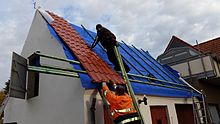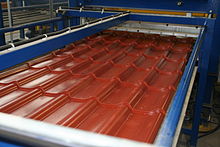Roof tile profile
Roof tile profiles are rolled and stamped profile sheets from steel strip (in contrast to trapezoidal sheet metal and corrugated sheet metal , the cross-sections of which have trapezoidal or curved lines). Tile profiles (also known as sheet metal sheets) are mainly used in agriculture and in the private customer segment for the roofing of ancillary buildings. Due to the noise of the rain, hardly inhabited buildings in Germany are covered with roof tile profiles.
Manufacturing, material and corrosion protection
As with trapezoidal sheet metal, the most common starting material is sheet steel with a thickness of approx. 0.35 to 0.75 mm. The sheet metal, which may have been coated beforehand, is fed from a coil (sheet metal roll) through a roll former ( roller train in the cold forming process with a large number of consecutive rollers ), creating an endless profile which is then cut to the desired length with profile shears . The punching takes place in the last work step before the shear. The color coating can be "deep drawn" and therefore does not tear when deformed / punched, supported by coolants and oils.
To protect against corrosion , steel sheets are galvanized and coil- coated as standard . Coil coating is possible in many different colors and coating thicknesses. Further coating variants are aluzinc coating (Galvalume (R), improved corrosion protection compared to just pure galvanizing), organic coating (ArcelorMittal Granite (R) Cloudy) and thin coating (DU, color strength approx. 15 μm). Since roof coverings with a tile profile should mostly resemble the classic roofing with roof tiles , classic colors such as black, anthracite, brick red, reddish brown or green are predominantly used, with any available RAL color being possible.
Special sheet metal variants are:
- Sandwich panel in the shape of a roof tile
- Anti-drumming coated sheets
- Anti-drip coated sheets (to absorb any condensation that may form )
Statics
Statics as with classic trapezoidal sheet metal are only available to a limited extent, as the roof tile profile as well as classic roof tiles (depending on the type) have a support point approximately every 350 mm and are screwed there. Since the roof tile sheets are usually attached very steeply, they are not accessible.
As with trapezoidal sheet metal, a production-related maximum length is different for the roof tile profile; the width depends on the infeed width of the coil.
use
Roof tile profiles are used for roof coverings. In Germany, they are mainly used in outbuildings, garden sheds or in agriculture. They are rarely used in industrial construction, since trapezoidal profiles and high profiles are more suitable for use as roof or facade coverings and can be processed more quickly. Especially when renovating or re-roofing older buildings, there are reasons for replacing classic roof tiles made of clay or concrete. The main reasons that speak in favor of using a roof tile profile:
- The low weight
- The rapid construction progress
- The comparatively low cost of assembly
- In the case of renovation, the substructure of the previous roofing can continue to be used without adjustment if it is suitable.
Disadvantage:
- Soundproofing
- condensation
- Susceptibility to vibration
See also
literature
- Gerhard Huber ao: Building materials science - technology of building materials . MANZ Verlag Schulbuch GmbH, Vienna 2002, ISBN 3-7068-1209-6 .
- Christof Riccabona : Building construction theory 5 . MANZ Verlag Schulbuch GmbH, Vienna 2003, ISBN 3-7068-1511-7 .
- Ralf Möller u. a .: Planning and building with trapezoidal profiles and sandwich elements Volume 1: Basics, construction methods, dimensioning with examples. Ernst & Sohn, Berlin 2004, ISBN 3-433-01595-3 .
- Ralf Möller u. a .: Planning and building with trapezoidal profiles and sandwich elements Volume 2: Construction atlas. Ernst & Sohn, Berlin 2011, ISBN 3-433-02843-5 .


